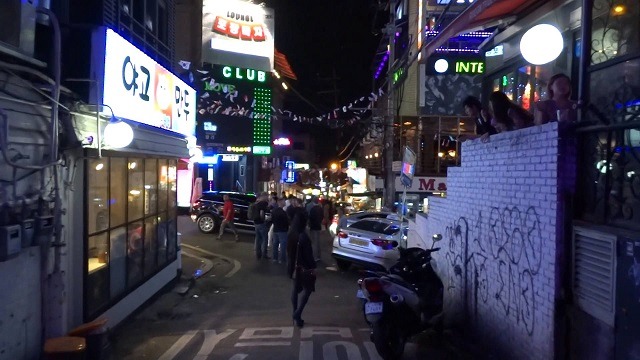Most red-light districts in South Korea are actually pink-light districts and, despite the fact that both buying and selling sexual services is illegal, they remain hugely popular with locals and tourists alike.
For some, this can come as a surprise but with the sex trade in South Korea generating almost $15 billion each year, it’s business as usual for Korean prostitutes,
In this guide, we look at some of South Korea’s most famous red-light districts including the infamous Hooker Hill and Cheongnyangni 588.
Seoul
Hooker Hill (Itaewon)
One of Seoul’s most famous streets, Hooker Hill (a few minutes’ walk from Itaewon station) was predominantly a sector of the city where US military could get sex. One of the main reasons this red-light area endures in the capital is because of the sex tourist. With a history, largely of American serviceman, most (if not all) of the women in this area speak English.
The street is lined with grubby looking windows (as well as regular shops and businesses) behind which women scour the street for potential customers. If you make eye contact, she will be likely to pop out and greet you. It’s usual to be invited straight inside what looks like a one-room bar for a drink where she (or a mamasan) will want to negotiate with you; this is generally not done in the street. The going rate varies by woman, time of day and even depending on what you look like but an average of $50-60 can buy you a quickie but $90 will get you a good half hour. The standard service is a quick full service.

The action takes place either in the bar room itself (don’t worry it’s private) or a through room; you may even be taken to a separate guesthouse across the street.
Most rooms are well-kept and clean and usually offer washing (if not showering) facilities for after.
The area, despite police surveillance is usually pretty busy, particularly after dark, and customers are guaranteed to be approached by someone whether it’s in a bar, the street or from a doorway directly.
Cheongnyangni 588
One of the country’s most famous red-light districts and home to almost 1000 prostitutes during the peak of its operations in the 1980’s, Cheongnyangni 588 (or “Oh Pal Pal’ (588)) has been under threat of redevelopment for the last two decades.
Though any demolition or construction work is still to be seen on a large scale, the combination of building work and the changes in the laws has led to a wind down in the sex trade in Cheongnyangni.

Mia-ri
The most popular red light district for South Korean locals, Mia-Ri (Miari Texas) can be found in the Hawolgok-dong area of the Seoul.
Though there are a couple of hundred brothels here, most do not provide any kind of service to non-nationals.
Busan
Birthplace of the modern sex industry, Busan is the location of the first brothels established by the invading Japanese troops in 1904.
Wanwol-dong
The most infamous red light district of Busan is the Wanwol-dong. Similar (in theory) to Amsterdam’s windows, the Wanwol-dong consists of a maze of alleyways in which glass houses line the streets. Ostensibly small rooms with three sides made of glass and a mirrored back wall, these ‘booths’ offer sex tourists a chance for some real window shopping. Women tend to sit or pose on chairs beneath giveaway pink/red lights
Situated in the Busan Seo-gu area of town, customers can select from older Korean ladies to younger ladies -for about $75-$100.
Haeundae Beach
The Haeundae Beach area of Busan is pretty lively in general and offers more than just the glass house experience. Due to the proximity of the neighbouring US military bases a whole host of establishments offer sex for sale including barbers, internet cafes and tearooms. There are your traditional saunas, love hotels and massage parlours all vying for trade.
Daegu
Jagalmadang
One of the most notoriously famous red-light districts of South Korea, Jagmaldang again rose to prominence during Japanese occupation. Operating brothels to service the troops, the Japanese military lined the streets with gravel so that potential escapees could be heard and re-captured.
Jagmaldang is one of the big three red-light districts in South Korea and, although diminished in size from the pre-2004 glory days, it still has a couple of hundred prostitutes servicing the masses.

Customers can find women still working the streets and bars but can also find suitable establishments by looking for pink lights (yes, pink not red).
Gyeonggi Province
Suwon Train Station, Palwal-du
There are still some military personnel using the area which makes it easier for foreigners to access services and it is common to be approached in bars or on the street.
Yongjugol, Paju
Another red-light area established for military comforts, Yongjugol has massage parlours and kissing rooms. Mainly popular with locals, the karaoke bars do a busy trade to entertain Korean men looking for sex.
Remember, prostitution is illegal in South Korea and we cannot recommend that you look for sex in any of these locations. Doing so runs the risk of landing yourself in trouble with the law. However, the industry is widespread and difficult to miss. With $15 Billion per year in transactions, that shouldn’t come as a surprise!
